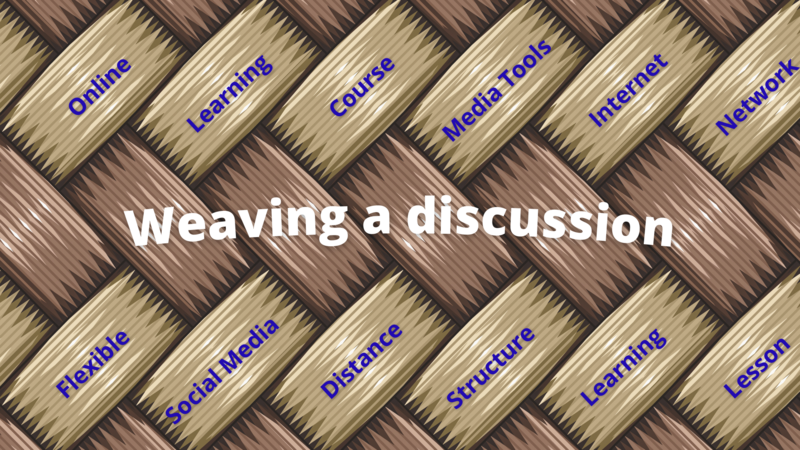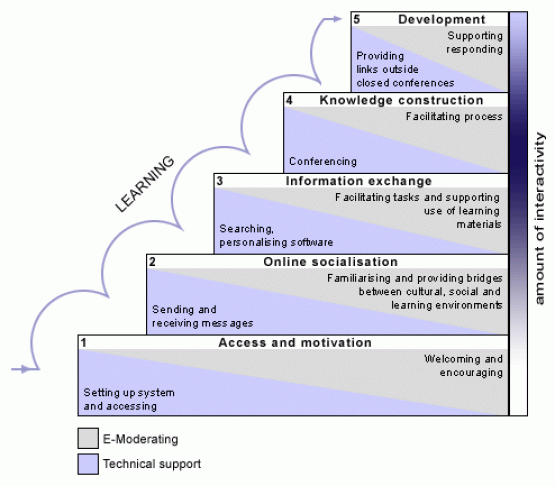CS4ODFL WS/Facilitating and moderating an online community/Weaving
“Weaving” To Create Meaningful Discussions
As an online facilitator, you also act as a moderator on course discussion boards. Your role is to not only engage with your online learners, but also help to facilitate, direct, and encourage learning. You do this by weaving quotes from post and responses and wrapping up the discussion session. To make effective weaving, you start by creating a powerful online discussion forum that provides remarkable possibilities for positive reinforcement, more interactions, and higher engagement, as well as allowing for more discussion on course content. Facilitators can regulate the flow of discourse between learner-to-learner and instructor-to-learner by weaving and wrapping. As illustrated in the figure below, weaving a traditional pandanus mat can be used as an analogy to weave an online discussion. The different strands of the mat represent the various contributions of the online learners that are woven by the facilitator to extract meaning from the discussion.
Read the extract below from “Creating meaningful online discussions” by Mary Harris-John. It highlights weaving can create meaningful discussions.
The modes of communication that we utilise in online courses include mainly e-mail, discussion boards, and chat rooms. Since instructors and students usually cannot see one another, the tone of our online “voices,” as well as the content of our messages, becomes critical to learning. I have speculated that some students are reticent to “speak” in online discussions until they feel comfortable enough to do so, and I have observed in my own courses that many students tend to connect closely with only one or two others in the class, versus the larger group. This suggests to me that in the case of online discussions, there may be safety in smaller numbers. Many students also tend to wait and read others’ postings and the comments made to them by their peers and the instructor before they venture out into the discussion arena.
The instructor’s toolkit includes artful wordsmithing through the conversations carried on via the discussion board. How well students learn from discussions (which take the place of in-class exchanges) depends on the contributions of other students in the course, as well as how skillfully the instructor “weaves” together the thoughts and ideas expressed throughout the threaded discussions.
“Weaving” involves a single reply to several students based on the topic as well as the relationships created by students’ postings, and it affords the instructor the opportunity to influence and guide the direction of the discussions, as well as get to know the students better. Weaving also involves summarizing main points proposed at a certain point in the discussion, as well as posing some pertinent questions (Salmon, 2003).
The style of postings varies by academic discipline and level of the learner, but also by the skill of the instructor. The tone of postings can be warm and reinforcing, or terse and clinical depending on the style and content of the replies. As students post their responses to discussions in the online course, the instructor plays a very important role in guiding the discussion by knowing when and how to respond. It is rather an art knowing when and how to participate in the discussion.
Students need to know at the outset of the course exactly what is expected of them in their discussion board postings (i.e., staying on topic, rules of responding to others in a respectful, collegial manner, quality and quantity of postings, the use of citations, academic honesty, etc.). The instructor can ascertain after just a few students’ initial postings whether the discussion is addressing the central issues expected. A well-placed and nicely-worded question or comment from the instructor can get a meandering discussion back on track.
Students will often offer unexpected elements in a discussion, and when it is insightful and relevant to the course, the instructor has a golden opportunity to recognize the student’s contribution, which can result in subsequent postings by that student and by those who had been feeling a bit more timid about posting responses. This may actually encourage them to participate. Instructors can encounter these “teachable moments” even in the online discussion environment, and should seize the opportunity to ask questions, and “weave” together students’ ideas, making connections with other students’ postings. By doing so, the instructor encourages students to expand on their own comments and make connections to others’ ideas. By the use of weaving, the instructor invites students to say more on a topic, points out specific issues to other students, and tries to find commonalities among several postings.
In course discussions, there is usually a flurry of posts as students excitedly discover the course system and look for particular group members. The numbers of posts, however, may decrease through lack of encouragement. With effective responding and the use of weaving techniques, the instructor can continually engage the students. Students, as well as instructors, can become leaders in helping everyone in an online course to participate in discussions fully and effectively by reinforcing course content, and offering positive support for those who seem reticent about posting in discussion forums (McSporran & Young, 2002).
For “A step-by-step guide to weaving online feedback” click on this link: https://dynamind-elearning.com/step-step-guide-weaving-online-feedback/ Read the article to gain more information on what weaving is, and the steps to take to weave successfully.
Importance of e-moderation
Online moderation is at the heart of practically all ODFL activities, unless the course has been deliberately designed to be what is sometimes called a ‘standalone’ or ‘self-paced’ learning experience. In general, it means the practice of managing the online communications that can, and should, be taking place amongst the teacher, students and any other individuals involved.
This communication can be uni- or bi-directional, can be one-to-one in the sense of being between individual students or the teacher and an individual student or among all students taking the course or sub-groups organised in either a formal or informal way. This communication can be at a very basic level in that it can relate to the most administrative of tasks or activities (start and end times of assignments for example) or it can support simple clarification of issues and questions that arise. Such communications can also form part of the formal course activity such as with online role plays or may be part of the assessment procedures for the course in that students can be assessed on the quality and depth of their contributions to online discussions. So, all in all, getting e-moderation right for the course leader is vitally important and many people argue that effective e-moderation is crucial to the success of any ODFL endeavour.
Aspects that teachers need to consider when taking on the role of e-moderator for the first time include whether you use an existing set of such rules, or you set them up at the beginning of your course, it is useful to agree what is and what is not acceptable in terms of online communications during your course.
Gilly Salmon's five-stage model
For online learning to be successful and happy, participants need to be supported through a structured developmental process. Gilly's five-stage-model provides a framework or scaffold for a structured and paced programme for enabling active and participative online learning by individuals and groups.
Stage 1: Access and motivation
Participants need information and technical support to get started online, and strong motivation and encouragement to put in the necessary time and effort. Most learners will need some form of individual technical help at this stage as well as general encouragement to overcome their fear of the technology and any frustration they experience when 'the system' doesn't respond as expected. Access to technical support needs to be made available, for example through a telephone helpline, particularly when the participant is struggling to get online on his or her own.
Stage 2: Online socialisation
Some learners are initially reluctant to participate in written discussion forums, and they should be encouraged to read and enjoy others’ contributions for a short while before taking the plunge and posting their own messages. When participants feel at ease with the online culture and reasonably comfortable with the technology, they can contribute more confidently.
Stage 3: Information exchange
In this stage, information starts to flow, and participants generally become excited about the immediate access and fast information exchange. They also express concern about the volume of information suddenly becoming available and the risk of potential information overload. E-tutors can help participants to develop good time management and organisational skills. Two kinds of interactions are required from participants: interaction with the course content and interaction with people.
Stage 4: Knowledge construction
As interactions unfold and expand, many (but not all) participants engage in some active exploration, and in the process widen their own viewpoints and appreciate differing perspectives. By now, learners should be interacting and starting to collaborate in their knowledge construction. Problem-based and practice-based tasks are appropriate at this stage. E-tutors have an important role to play in building and sustaining groups.
Stage 5: Development
Participants begin to explore their own thinking and knowledge building processes. It is common at this stage for participants to reflect on and discuss how they are networking and to evaluate the technology and its impact on their learning processes. These higher-level skills require the ability to reflect on, articulate and evaluate one’s own thinking. Learners become responsible for their own learning and need little support beyond that already available. Experienced participants often become most helpful as guides to less experienced peers and may feel confident to confront e-tutors and provide them with feedback to help improve the learning process.
Watch this video for more information on Gilly's 5-stage model (watchtime: 7.16 mins).
Weaving online feedback is one of the most important tasks of ODFL facilitators. On the same note, the role of the e-moderator is promoting human interaction and communication through the modelling, conveying and building of knowledge and skills. Once learners are confident in their online learning environment, it becomes easier for them to form online connections and learning communities. These communities help further the course of learning beyond the classrooms.



